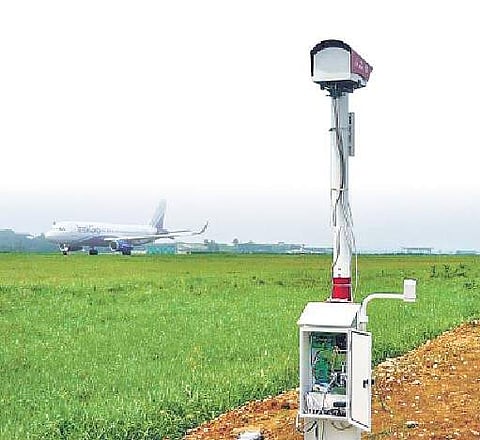

BENGALURU: Descending from the puffy clouds as the runway slowly looms into sight, the first-time flyers in the aircraft cabin and pilots in the cockpit would be silently praying for a perfect weather and safe landing.For, poor weather has been the cause of many accidents in the aviation sector. The visibility haze is still a main issue. However, aircraft turning back due to bad weather is a thing of the past. Even in dense fog, pounding rain or raging sandstorm, when visibility in an airport dips to as low as 50 metres, pilots with the help of ‘Drishti’ and Instrument Landing Systems (ILS) are able to land the aircraft safely on the tarmac.
What will surely warm the hearts of many is that ‘Drishti’, a transmissometer for precise reporting of visual range at airports, is a desi product. Drishti system was developed in the workshop of city-based CSIR-NAL (National Aerospace Laboratories). “Drishti is installed in all categories of airports and Air Force bases across the country has crossed a century,’’ declares V Shubha, a distinguished scientist, CSIR (Airport Instrumentation) -NAL and also a cricket buff.
The sophisticated instruments helping pilots while flying out of or approaching airports with an accurate runway visual range, cost just one-third of the price of systems imported from other countries. A mini version of Drishti is also being installed on highways, hilly terrains and railway stations particularly in northern India surrounded with thick fog between November and February, informs Shubha while retracing the journey of Drishti at a symposium organised in Bengaluru on the occasion of Sir M Visvesvaraya’s birth anniversary.
Nearly four years ago, aviation experts had hailed that a milestone was achieved in the field of navigation safety, when CSIR-NAL and India Meteorological Department (IMD) signed an agreement to install indigenous transmissometers in all airports. Transmissometers providing an accurate runway visual range is a mandatory system required at all airports as per International Civil Aviation Organisation and World Meteorological Organisation .
Until then, IMD was importing the instruments. Shubha with her brilliant academic record (first rank in BSc Hons (physics), MSc Physics (electronics) and fellowship for highest marks in Physics) and demonstrated passion for work, seemed a natural choice for the huge responsibility of making a success of the contract with IMD. Having joined NAL as a research fellow (in 1974), she had quickly moved up the ranks handling different scientific positions.
Until then, as head of materials science division, her world was restricted to fabricating complicated products that were able to withstand high heat, alloys, rare earth materials, among others. Shubha grabbed the opportunity to develop a robust and completely indigenous instrument. In 2011, Drishti was first installed at Indira Gandhi International (IGI) airport in New Delhi, which used to be severely affected by fog during winter.
Soon IMD was in talks with CSIR-NAL to install more Drishti transmissometers at different airports resulting in partnership agreement being signed in May 2014. Shubha is also hailed for grooming many skilled workers by encouraging them to make components locally for Drishti.The speciality of Drishti and another system developed by the team, ‘Aviation Weather Monitoring System (AWMS)’, includes integration of data like wind speed, wind direction, pressure, temperature, humidity on a single computer for Air Traffic Control (ATC) room and pilots, says Shubha.
As it is web-enabled, the data can be accessed and maintenance carried out from any location in the country. “Drishti system installed at IGI airport in 2011 has never had a failure of maintenance until today,’’ informs Shubha and beams that they ‘Made in India’ even before it became a catchphrase. AWMS with many novel features is also another ‘Made in India’ product.
CLEAR PATH
The website of IGI airport cites a survey by the Ministry of Civil Aviation which declares that by installing Drishti at IGI airport in Delhi (first airport in the country to have Drishti in all its three runways), overall flight operations had increased during low visibility by 67 per cent.
101, AND GOING STRONG
After Mangaluru International Airport (MIK), Kempegowda International Airport (KIA) became the state’s second airport in Karnataka to install the Drishti transmissometer. So far, CSIR-Nal has supplied 101 systems. Tatas had procured 54 Drishtis for 18 Air Force (IAF) bases. MIA is the first airport in the country to incorporate AWMS.
During dense fog, dust storm or heavy rains, Drishti transmissometer had provided accurate measurements and had performed better than the imported instruments. It is a valuable indigenous innovation meeting all international standards and is easy to maintain.
Kanduri Jayaram Ramesh.
India Meteorological Department (IMD) Director General
(harshaa@newindianexpress.com)